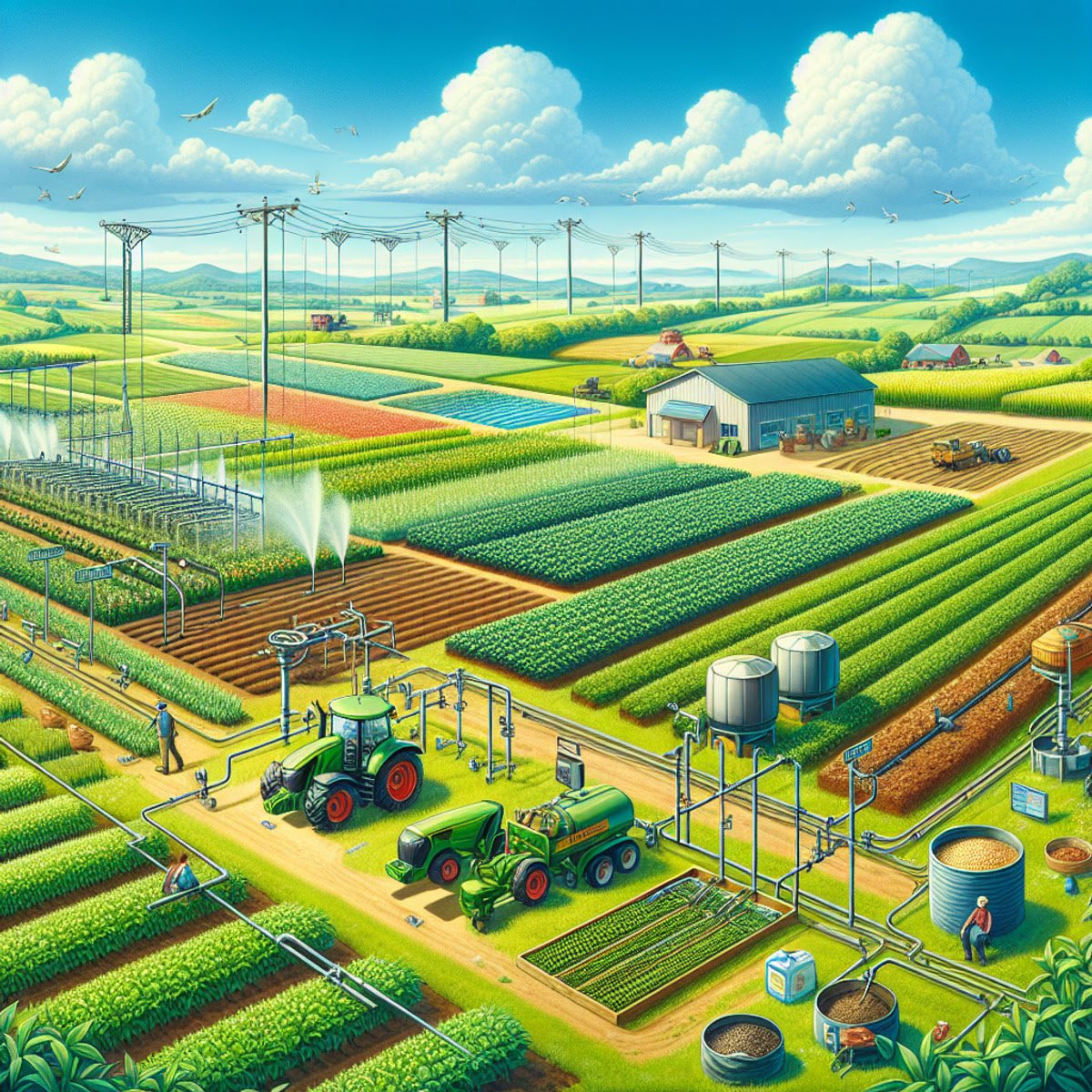What is Agricultural Productivity?
Agricultural productivity refers to the efficiency and output of agricultural activities, such as farming and crop production, in relation to the resources invested, including land, labor, capital, and technology. It essentially measures how much agricultural output is generated per unit of input over a given period. High agricultural productivity is crucial for meeting food demands, improving rural livelihoods, and promoting economic growth in agricultural-dependent economies.
In simple terms: Agricultural efficiency isn’t just about how much land we have. it’s also about how efficiently we use it. Productivity shows how much we get out of what we put in. It includes total production, how output changes over time, and how much we produce per hectare. Agricultural production measures the yield from each hectare of land we farm.
Read More: Demographic Features of Indian Population

Factors Determining Agricultural Productivity
- Irrigation Facilities: Adequate availability of irrigation facilities not only enhances agricultural efficiency but also encourages farmers to diversify crop cultivation. This contributes to both the quality and quantity of agricultural yields.
- Quality Seeds, Manure, and Fertilizers: High-quality seeds and fertilizers play a pivotal role in improving agricultural standards. Historically, the lack of access to suitable seeds, manure, and fertilizers has hindered agricultural productivity. Hence, ensuring their sufficient availability can significantly boost agricultural output.
- Agricultural Equipment: Access to appropriate agricultural machinery is crucial for enhancing productivity. The utilization of modern equipment such as tractors, harvesters, and power tillers reduces the time and cost involved in various farming operations, thereby increasing overall productivity.
- Scientific Cultivation: Emphasizing scientific agriculture practices, including crop selection, land preparation, seed quality, fertilizer application, and efficient farming methods, is instrumental in augmenting agricultural productivity.
- Ceilings on Land Holdings: Implementing land ownership limits ensures equitable distribution of cultivable land. Surplus land is redistributed to small farmers, tenants, or landless individuals, fostering agricultural employment and productivity.
- Soil Conservation: Addressing soil erosion through tree plantation and embankment construction helps preserve arable land. Efforts to mitigate water scarcity and conserve land resources contribute significantly to enhancing agricultural productivity.
- Agricultural Marketing: Facilitating fair pricing mechanisms for agricultural products incentivizes farmers to increase crop production, ultimately boosting overall agricultural yields.
- Agricultural Education and Research: Providing farmers with general and technical education enhances their knowledge base and encourages the adoption of innovative agricultural practices. Research initiatives and advancements in agricultural universities further contribute to improving productivity.
- Other Factors: Other determinants of agricultural efficiency include crop insurance for risk mitigation, pest control measures, cooperative farming initiatives, access to credit facilities, crop rotation, mixed farming practices, and efficient transportation infrastructure.
Read More: How Economic Growth has Damaged the Environment?

Trends in Agricultural Productivity
The per-hectare yield of food grains and other agricultural products has undoubtedly increased during the post-Plan period. There has been a consistent rise in agricultural productivity throughout the economic planning period. However, when comparing food grains to other products, the increase has been more pronounced. Agricultural efficiency has grown by approximately 3 percent annually from 1950-51 to 2019-20. Trends in agricultural efficiency are shown in Table
Progress of Agricultural Productivity (Kilograms Per Hectare)
| Crop | 1951 | 2010-11 | 2019-20 | 2020-21 |
|---|---|---|---|---|
| Rice | 668 | 3,176 | 3,569 | 3,530 |
| Wheat | 663 | 2,989 | 3,440 | 3,464 |
| cotton | 88 | 499 | 455 | 462 |
| Sugarcane | 3,342 | 70,000 | 80,000 | 82,000 |
| Jute | 1,043 | 2,329 | 2,641 | 2,595 |
| Maize | 704 | 2,540 | 3,006 | 3,195 |
Read More: Main Features of Indian Economy
Low Agricultural Productivity
The incidence of low productivity is not only evident in comparison to developed countries but also when compared to many underdeveloped nations. Even in the largest agricultural zones of India, the productivity of major crops falls below global standards. China, for instance, boasts a significantly higher productivity level, yielding approximately 630 million tonnes of food grains annually, which is more than twice the annual production of India. Moreover, China’s rice production surpasses that of India by 1.8 times. In Germany, the per-hectare yield of wheat exceeds that of India by 2.3 times. Similarly, South Africa’s maize production exceeds that of India by more than 3.5 times. Additionally, Indonesia’s sugarcane production per hectare is 50 percent of that in India.
After achieving statehood, agricultural production significantly increased as a result of concerted efforts aimed at rural agricultural development. However, India’s agricultural efficiency still lags far behind that of other countries. Therefore, it can be concluded that Indian agriculture is comparatively less advanced. Our per-hectare productivity is lower in comparison to other nations. A detailed comparison of India’s agricultural efficiency with that of other countries is provided in Table
Per Hectare Agricultural Productivity (2017)
| Crop | Country | Tones Per Hectare |
|---|---|---|
| Rice | India China Brazil Word Average | 3.8 6.9 6.2 4.6 |
| Wheat | India Germany China Word Average | 3.2 7.6 5.5 3.5 |
| Maize | India U.S.A. China Word Average | 3.1 11.1 6.1 5.8 |
Importance of Increase in Agricultural Productivity
Economic surplus is achieved through increased agricultural efficiency, which can be allocated towards several purposes:
- Reinforcing agricultural productivity further
- Facilitating industrial development
- Accumulating capital
- Fulfilling the growing consumption demands of urban populations.
Additionally, enhancing productivity in the non-agricultural sector is imperative to optimize labor and resources, thereby releasing them from agricultural activities. This shift promotes growth; as agricultural productivity rises, fewer agricultural workers are required, allowing surplus labor to contribute to non-agricultural sectors, thus enhancing overall production.
Furthermore, augmenting the purchasing power of rural communities is essential to stimulate demand for industrial goods, expanding market opportunities. Therefore, enhancing agricultural productivity in India is indispensable for fostering comprehensive economic development.
Read More: Problem of Poverty in India
Conclusion
In conclusion, understanding the trends, determinants, and strategies for enhancing agricultural productivity is crucial for sustainable agricultural development. By recognizing the importance of irrigation facilities, quality seeds, agricultural equipment, and scientific cultivation practices, we can unlock the potential for increased productivity in the agricultural sector. Moreover, addressing factors such as land ownership ceilings, soil conservation measures, and agricultural marketing initiatives can further propel growth in agricultural output. With a concerted effort to implement these strategies, we can pave the way for a more productive and resilient agricultural system, ultimately contributing to food security, economic growth, and environmental sustainability. Let’s work together to cultivate a brighter future for agriculture and ensure a bountiful harvest for generations to come.
Read more about – Agricultural Productivity
FAQ on Agricultural Productivity: Trends, Determinants, and Strategies for Improvement
What is Agricultural Productivity?
Agricultural efficiency refers to the efficiency and output of farming activities in relation to the resources invested, such as land, labor, capital, and technology. It measures how much agricultural output is generated per unit of input over a given period.
What are the key Factors Determining Agricultural Productivity?
1. Irrigation Facilities
2. Quality Seeds, Manure, and Fertilizers
3. Agricultural Equipment
4. Scientific Cultivation
5. Ceilings on Land Holdings
6. Soil Conservation
7. Agricultural Marketing
How has agricultural productivity evolved over time, and what are the current trends?
Agricultural efficiency has evolved significantly over time, driven by advancements in technology, farming practices, and infrastructure. Current trends indicate a focus on sustainable practices, precision agriculture, and the integration of digital technologies to optimize yields while minimizing environmental impact.
How can soil conservation practices contribute to enhanced agricultural efficiency?
Soil conservation practices help maintain soil fertility, prevent erosion, and improve water retention, ultimately leading to healthier and more productive farmland.
What strategies can farmers employ to improve agricultural efficiency on their farms?
Farmers can improve agricultural efficiency by adopting strategies such as crop diversification, soil conservation techniques, precision farming, use of high-quality seeds and fertilizers, efficient irrigation methods, and integrating technology for better farm management.


[…] Read More: Agricultural Productivity: Trends, Determinants, and Strategies for Improvement […]